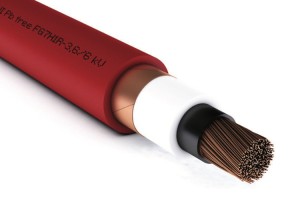The sheath of a cable is the cable protective shield. The purpose of the sheath is to prevent any kind of accident, guaranteeing a total isolation of the vital areas of the cable from the external environment.
The wrong choice of a cable for a specific laying, can become a risk for the environment safety and for its inhabitants. Electric components manufactures rely on the science of materials. Through the exploitation of the physical and chemical characteristics of synthetic and mineral materials, they optimize the primary and secondary insulations of cables, ensuring high safety standards and an excellent product performance.

Classification of sheaths according to the material or compound used
As mentioned in the introduction, companies operating in electronics and robotics, rely on the science of materials, to implement suitable isolation devices and conductors’ protection. Therefore, the characteristics of the sheaths are strictly related to the materials used. Below, you will find a short description on the main sheaths used for protecting the primary and secondary coating of electrical cables.
Polyethylene PE sheath cables
Polyethylene (PE) is, perhaps, one of the most common materials in both domestic and industrial environments. 40% of the plastics production of the world is covered by polyethylene. The great diffusion and use of such a plastic is directly proportional to its technical specifications. First of all, it is a very light material. Therefore, it is very suitable for reducing the weight of wires, for special laying that require weight reduction. Other features that make polyethylene unique, are its high resistance to chemical agents, saline solutions, acids, alkalis, petrol. PE also has a high water resistance. The only weakness of the polyethylene is its incompatibility with oxidizing acids such as nitric and sulfuric acid. Its non-toxic composition is 100% guaranteed, in fact, it is widely used in the agro-food industry. The thermal endurance of the material ranges between – 40 ° C and + 80 ° C, thus ensuring a high stability.
Polyethylene can be easily welded. However, it is hard to glue. It is characterized by a high impact resistance (even at low temperatures) and low coefficient of friction, with excellent non-stick properties. These characteristics make polyethylene particularly suitable for movable cable installations, in places where you have to stem the danger of release of harmful gases by thermal effect. Also given its low dielectric constant (er = 2.3), polyethylene is widely used for equipment such as frequency meters, oscilloscopes and benchtop precision instrumentation.
Polyvinylchloride (PVC) thermoplastic sheath cables
The poly-vinyl chloride PVC is catalogued as a thermoplastic material with an amorphous structure. It is also characterized by high hardness and elasticity. The average operating temperature of the PVC varies between -10 ° C and + 60 ° C. Specific variants of the compound allow to increase the operating temperature up to + 125 ° C. Moreover, subjected to thermal stress, PVC maintains a satisfactory weaving stability and chemical composition. Moreover, its high resistance to acids, makes it a popular material in the petrochemical industry.
However, the main technical specification of the PVC, concerning the electronics, is its high halogen power, due to the presence of chlorine in its blend. Its high self-extinguishing capacity, makes it particularly suitable for particular installations, in environments with a high fire and explosion risks. It is not by chance, that the majority of fire extinguishing elements, are coated with PVC. Many PVC insulated cables are used in power systems and devices that control industrial equipment.
Polyester-based thermoplastic elastomer sheath cables (TPE-E)
The TPE-E possesses high thermal and elastic properties associated with an excellent resistance to mechanical stress from shock and good abrasion resistance. Its operating temperature is between -70 and + 175 ° C.
As for the PVC, the TPE-E is almost exclusively used for security and alarm systems, having excellent fireproof characteristics.
Thermoplastic elastomer sheath cables (TPE-O)
Thermoplastic elastomer sheath cables (TPE-O) are used for the insulation of wires, especially in industrial areas. They are more specifically used for spiral and extensible cables and generally, wherever flexibility and resistance are of crucial importance.
Flame retardant and low outgassing sheath cables
Special blends are processed to ensure high flame retardant and fire resistant powers. Cables with such coating sheaths are common in public open spaces, where there is the need for restricting the emission of opaque and noxious fumes in case of fire, to ensure visibility for escape routes.
